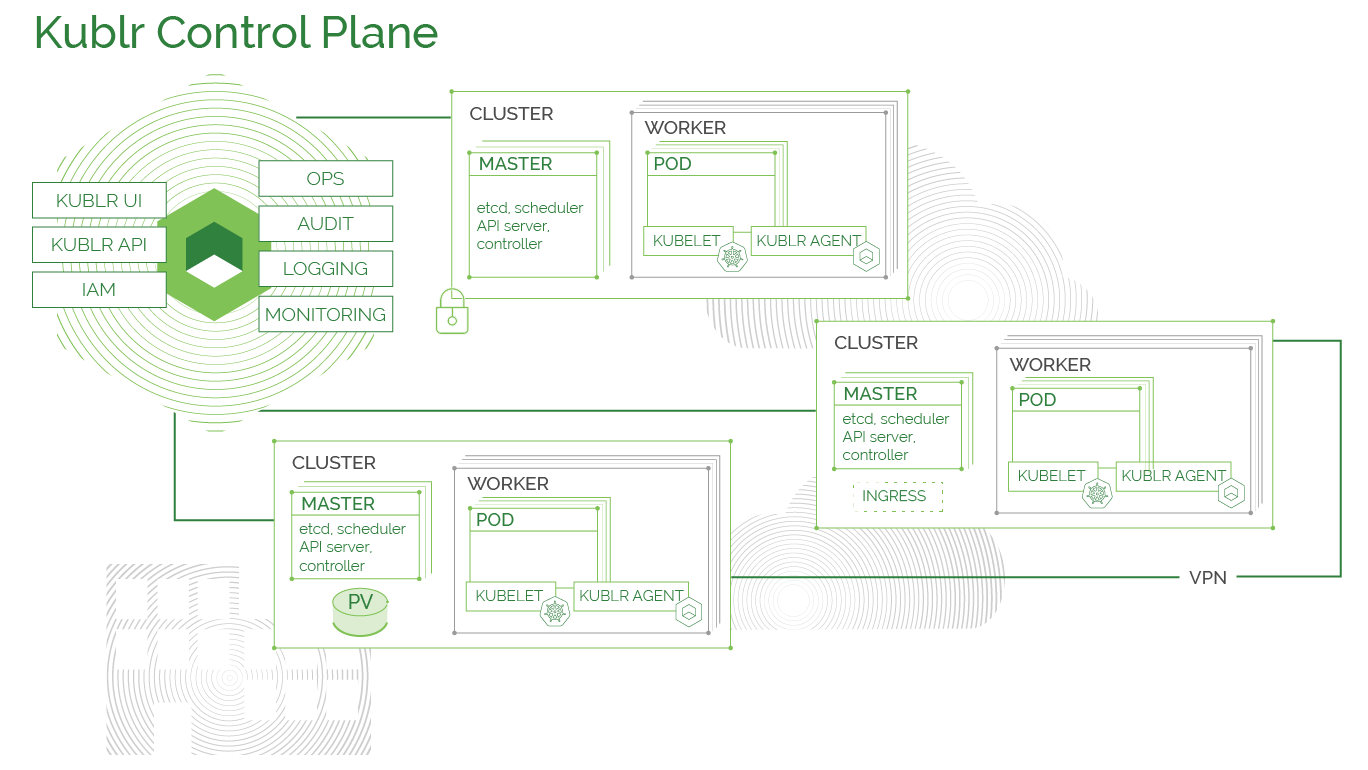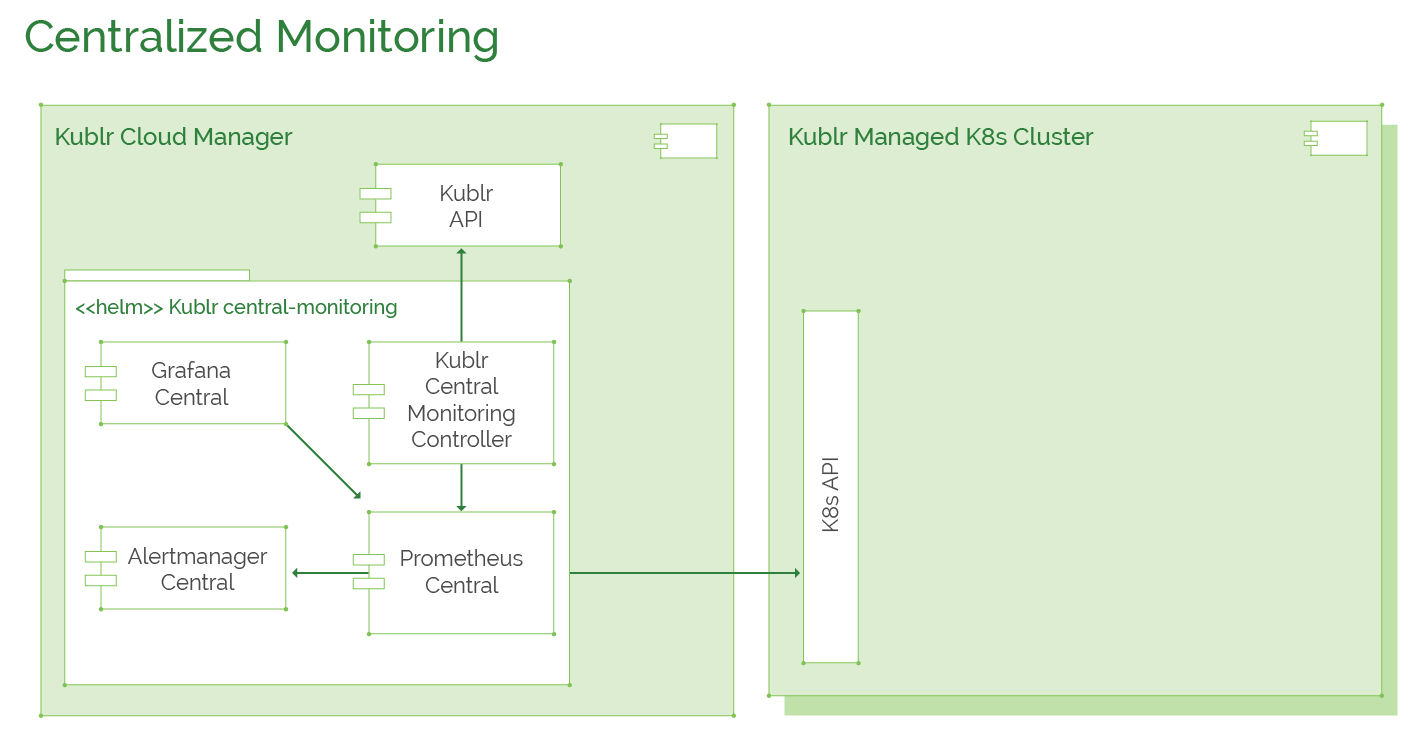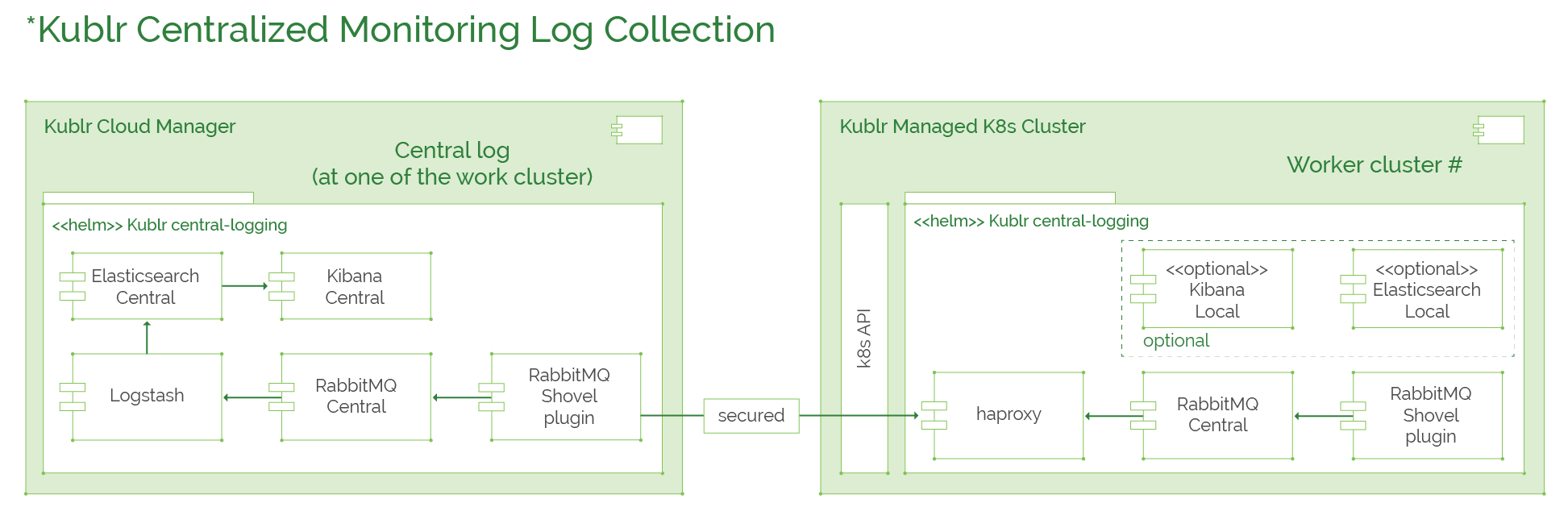This document outlines the main aspects of Kublr’s general architecture. Kublr is a Kubernetes management platform which accelerates and controls the deployment, scaling, monitoring and management of Kubernetes clusters.
The diagram below describes two main elements of Kublr architecture:

Kublr Platform (at the top-left) is the main management portal for your Kubernetes clusters. Kublr Platform consists of a number of integrated management components deployed into a Kubernetes cluster themselves.

The Kublr platform components include:
A Kubernetes cluster is the main management object for the Kublr Platform. In most cases the Kubernetes clusters are provisioned by Kublr Platfrom, although since Kublr 1.18.0 externally provisioned clusters (e.g. GKE, AKS, etc) are also supported.
Kublr configures four architectural layers. After being correctly setup and configured (usually by a higher layer), each layer is self-sufficient, self-healing and self-reliant. As long as the underlying infrastructure and layers are functional, each layer functions without interruption.
Layers at play:
The infrastructure layer includes virtual and/or physical machines/servers hosted in a datacenter or in a cloud (e.g. AWS, Azure). Kublr sets up and manages Kubernetes on top of any virtual infrastructure or multiple OS, although some infrastructure providers allow better automation than others. When setting up instances in any environment—either a Kubernetes master or node—Kublr ensures they are fully replaceable should an instance failure occur.
In AWS and Azure, Kublr enables self-healing on an infrastructure level via AWS’ auto-scaling groups and Azure’s VM auto-restart. On-premises, in case of a failure, any virtual and physical machines can be easily replaced, using manual or infrastructure automation tools of choice.
The Kublr Agent is a single binary running as a service on every Kublr instance, both masters and workers.
The Kublr Agent is then responsible for configuring Kubernetes components on machines and connecting them into the Kubernetes cluster as described above.
As a result, a new Kubernetes cluster is started on provisioned infrastructure and connected to the Kublr Control Plane with centralized authentication, monitoring and logging.
The Kublr agent’s responsibilities include:
The Kubernetes layer includes all standard Kubernetes components - etcd cluster, Kubernetes master components (API, scheduler, controller manager etc.), kubelet, kube-proxy, various Kubernetes add-ons, such as DNS, dashboard, overlay network provider, auto scaler etc.
Kublr sets up and connects Kubernetes components on each instance so that communication between them is secure, reliable, and able to recover from failures as long as and as soon as the underlying infrastructure is recovered.
Kublr uses unmodified standard Kubernetes components and Kubernetes configuration best practices ensuring secure, reliable, and standard conformant Kubernetes setup.
Kublr management layer includes optional components deployed by Kublr into the provisioned or managed Kubernetes cluster to integrate it with Kublr Platform cluster management facilities or provide additional functionality in the managed clusters: such as centralized and local log collection and monitoring.
Diagram below depicts main components of Kublr Cluster and Kubernetes:

Kublr’s centralized monitoring capability is built on top of the Prometheus and Grafana. Each cluster is registered as a metrics source in Prometheus. Kubernetes provides cloud, hardware, OS, Kubernetes and application metrics using the Kubernetes API of each cluster respectively. Kublr manages metrics source lists in Prometheus, while Grafana’s single sign-on integration with the Kublr Control Plane provides easy access to key dashboards. The centralized monitoring component is deployed as a Helm package.

Kublr’s centralized log collection capability is built on top of the Elasticsearch, Logstash, and Kibana stack. In addition, for better resilience RabbitMQ is used to accamulate the remaining log entries between sync up sessions. On a Kublr cluster level, Helm package with RabbitMQ, FluentD and haproxy is deployed. FluentD collects log entries from all levels: hardware, OS, pods, Kubernetes and Kublr core components. RabbitMQ is configured to be the primary destination for all collected logs and haproxy used for data channels between the Kublr Platform and Kublr clusters through Kubernetes port-forwarding feature.
On the Kublr Platform side, the Kublr-central-logging helm package includes Elasticsearch, Kibana, Logstash with RabbitMQ and the RabbitMQ Shovel plugin. The latter transfers messages to the centralized RabbitMQ where they are digested by Logstash and stored in Elasticsearch. Kibana, integrated with Kublr through single sign-on, provides a convenient UI to access and search log entries from all clusters.
In addition to centralized log collection, local Elasticsearch and Kibana may be installed by the user. They act in parallel with centralized log collection mechanism.

The Kublr Backup Controller is deployed as a Kubernetes application. Its main responsibility is to make volume snapshots from all volumes attached to the clusters as specified in the backup schedule. Additionally, the Backup Controller is also responsible for purging old backup snapshots and cluster restoration logic from provided snapshot.